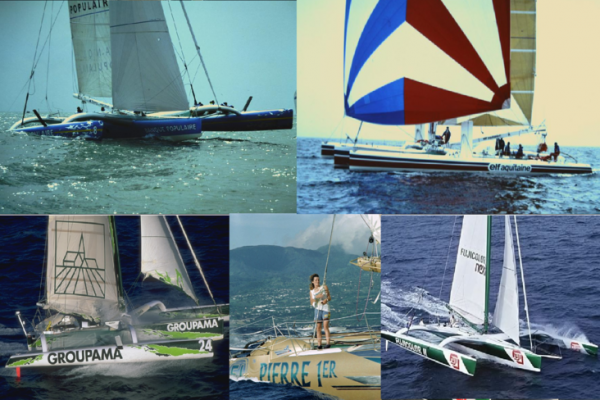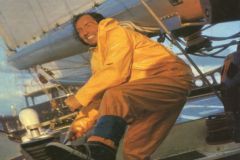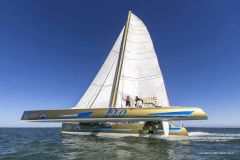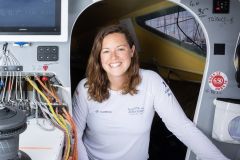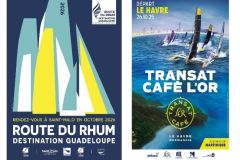Gilles Lamiré on Elf Aquitaine 3
Thirty-six years after her launch, the ex-Elf Aquitaine 3 is back in service. Launched in 1988 for Jean Maurel, this Ollier design made history with a series of victories and a long sporting career. Taken over in 2006 by Gilles Lamiré, the boat will once again line up at the start of the Route du Rhum 2026 under the colors of the Océanopolis Acts endowment fund. The aim is to combine environmental education with accessibility to the sea.
The project, based in Saint-Malo, involves an annual program costing 300,000 euros, financed by sponsorship.
Fujicolor II: Damien Seguin on a legendary trimaran
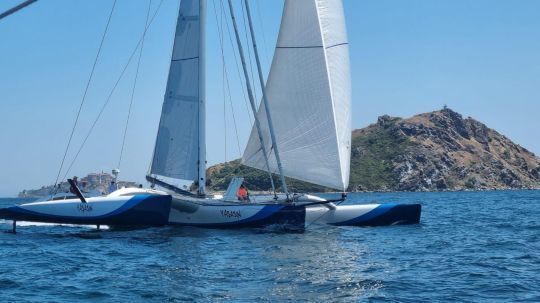
The former Fujicolor II, sailed in the 90s by Loïck Peyron, will be back on the Atlantic in 2026, this time with Damien Seguin at the helm. For lack of space in an Ocean Fifty, the two-time Paralympic medallist has opted for this Irens design, which he is modernizing with the help of Franck Proffit and the Éole Performance team. The refit will focus on a new set of sails, a possibly shortened mast and an adaptation of the cockpit. The announced budget is around 1.2 million euros.
The aim is clear: to combine sporting performance and a message about disability, with partners committed to the cause.
Pierre 1er: Loizeau pays tribute to Florence Arthaud
At the age of 76, Éric Loizeau is back for a third Route du Rhum. At the helm of the former Pierre 1er, Florence Arthaud's winning trimaran in 1990, he is making an emotional comeback. The boat, now christened Flo, will be made reliable for a heritage and environmental program focused on the fight against plastics and intergenerational transmission.
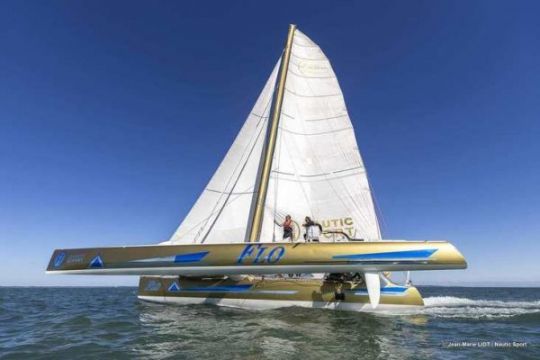
Loizeau is planning a budget of 500,000 to 600,000 euros, based in Brest from the summer of 2026, with a project focused on mast reduction and a new mainsail. He is appealing to institutions, foundations and patrons who share his values to support this intergenerational project.
Banque Populaire / Eure-et-Loir : Joyon returns with Océans
Francis Joyon has reclaimed his former ORMA, built in 1994 and ex-Banque Populaire, and transformed it into a vehicle for ecological commitment. Renamed Océans, the trimaran already takes part in regattas and awareness-raising events. After a major decarbonization and simplification project (second-hand sails, lighter electronics), Joyon is preparing for the Route du Rhum 2026 with a sober, artisanal approach, resolutely focused on environmental causes.
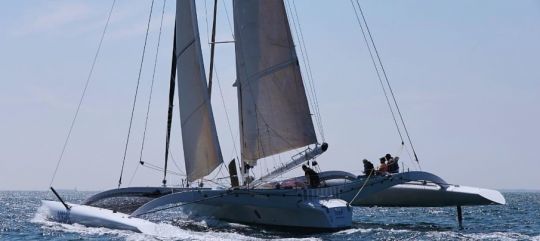
The skipper hopes to use his project as a relay for NGOs working to protect cetaceans and reefs. He also plans to take part in the Fastnet Race 2025. His return to the Rhum Multi class is in line with his commitment to continuity, far from the Ultim budgets, but with a strong technical and human coherence.
Other potential ORMAs undergoing refit or in operation
Two other trimarans could also join this dynamic. The former Groupama 1, currently undergoing a refit in Marseille, is being refitted with a view to a possible return to racing. This 1998 VPLP design, which marked the technological transition from ORMAs to more powerful platforms, has not yet confirmed its participation, but remains a credible option.

Another emblematic boat is the former Foncia, now operated by Lorient-based Sensation Océan. Used for public relations operations and educational outings, this trimaran is regularly maintained and, should the budget go ahead, could also line up at the start of Saint-Malo. These boats, which are still in operation, testify to the potential of the ORMA fleet, which has long been sidelined and is now being rehabilitated for human, educational and sporting projects.
A class in relief
With these projects, the Vintage class is enriched by emblematic figures and mythical multihulls. A dynamic heritage that reaffirms the place of ORMAs on the oceanic scene. These 60-foot platforms, often relegated to anchorages, find a new lease of life through committed, sober or symbolic projects.

 /
/ 